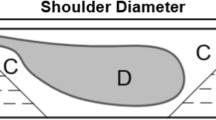Abstract
Friction stir welding is a relatively new joining process, which involves the joining of metals without fusion or filler materials. The amount of the heat conducted into the workpiece dictates a successful process which is defined by the quality, shape, and microstructure of the processed zone, as well as the residual stress and the distortion of the workpiece. The amount of the heat gone to the tool dictates the life of the tool and the capability of the tool to produce a good-processed zone. Hence, understanding the heat transfer aspect of the friction stir welding is extremely important, not only for the science but also for improving the process. Many research works were carried out to simulate the friction stir welding using various software to determine the temperature distribution for a given set of conditions in weldments. Very few attempted to determine the maximum temperature by varying the input parameters using ANSYS. The objective of this research is to develop a finite element simulation with improved capability to predict temperature evolution in stainless steel. The simulation model is tested with existing experimental results obtained by Zau et al. on 304 L stainless steel. The results of the simulation are in good agreement with that of experimental results. The peak temperature obtained was 1,056.853°C, which was much less than the melting point of 304 L steel (1,450°C). Error analysis is done between theoretical values for 304 L steel obtained from ANSYS and experimental values obtained by Zhu. Mean relative error is calculated between theoretical values for 304 L steel and experimental values.
Similar content being viewed by others
References
Colegrove P, Painter M, Graham D, Miller T (2000) 3-Dimensional flow and thermal modeling of the friction stir welding process. Proceedings of the Second International Symposium on Friction Stir Welding, June 26–28, Gothenburg, Sweden
Chao YJ, Qi X, Tang W (2003) Heat transfer in friction stir welding—experimental and numerical studies. ASME J Manuf Sci Eng 25:138–145
Frigaard G, Midling OT (1998) Modeling of the heat flow phenomena in friction stir welding of aluminum alloys. Proceedings of the Seventh International Conference Joints in Aluminum—INALCO ’98, Cambridge, UK, April 15-17, pp 1189-1200
Frigaard G, Midling OT (2001) A process model for friction stir welding of age hardening aluminum alloys. Metallurgical and Materials Transactions A, Physical Metallurgy and Materials Science 32A (5) May 2001, ASM International, pp. 1189-2000. 32A
Chao YJ, Qi X (1998) Thermal and thermomechanical analysis of friction stir joining of AA6061-T6. J Mater Process Manuf Sci 7:215–233
Reynolds AP, Lockwood WD, Seidel TU (2000) Processing–property correlation in friction stir welds. Mater Sci Forum 331–337:1719–1724
Colegrove PA, Shercliff HR (2003) Experimental and numerical analysis of aluminium alloy 7075-T7351 friction stir welds. Sci Tech Weld Join 8(5). IoM Communications Ltd, pp 360-368
Song M, Kovacevic R. Numerical and experimental study of the heat transfer process in friction stir welding. Proc Inst Mech Eng USA 217 Part B: J Eng Manuf
Chen CM, Kovacevic R (2003) Finite element modeling of friction stir welding—thermal and thermo-mechanical analysis. Int J Mach Tools Manuf 43:1319–1326
Schmidt H, Hattel J, Wert J (2004) An analytical model for the heat generation in friction stir welding. Model Simul Mater Sci Eng 12:143–157
Zhu XK, Chao YJ (2004) Numerical simulation of transient temperature and residual stresses in friction stir welding of 304 L stainless steel. J Mater Process Technol 146:263–272
McClure JC, Tang W, Murr LE, Guo X, Feng Z, Gould JE (1998) A thermal model of friction stir welding. International Conference on Trends in Welding Research 349:156–165
Ulysse P (2002) Three dimensional modeling of friction stir welding process. Int J Mach Tools Manuf 42:1549–1557
Soundararajan V, Zekovic S, Kovacevic R (2005) Thermo-mechanical model with adaptive boundary conditions for friction stir welding of Al 6061. Int J Mach Tools Manuf 45:1577–1587
Buffa G, Huaa J, Shivpuri R, Fratini L (2006) A continuum based fem model for friction stir welding—model development. J Mater Sci Eng A419:389–396
Dickerson T, Shi Q-Y, Shercliff HR (2003) Heat flow into friction stir welding tools. Proceedings of 4th international symposium on friction sitr welding, USA, pp 14-16
Hwang Y-M, Kang Z-W, Chiou Y-C, Hsu H-H (2008) Experimental study on temperature distributions within the workpiece during friction stir welding of aluminium alloy. Int J Mach Tools Manuf 48:778–787
Author information
Authors and Affiliations
Corresponding author
Rights and permissions
About this article
Cite this article
Prasanna, P., Rao, B.S. & Rao, G.K.M. Finite element modeling for maximum temperature in friction stir welding and its validation. Int J Adv Manuf Technol 51, 925–933 (2010). https://doi.org/10.1007/s00170-010-2693-4
Received:
Accepted:
Published:
Issue Date:
DOI: https://doi.org/10.1007/s00170-010-2693-4




